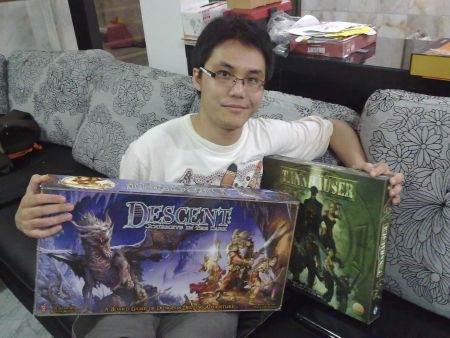Everyone knows the likes of World of Warcraft, a popular example of MMORPGs (Massively Multiplayer Online RPGs in full).
You play a character, start equipping it with spells and equipment, and enter into adventures, quests and wars. You do all these from the comfort of your own computer, thanks to a (hopefully good) broadband connection.
MMORPGs owe their existence to computer game RPGs, the like of which were played mano-y-mano between you and the PC.
Now, such RPGs in turn trace their origins to the pen-and-paper RPGs. For the uninitiated and the young, such games are played in groups, with one of the individual becoming the ‘gamemaster’ (GM). The rest of the players are essentially the adventurers – often called ‘PCs’, short for Player Characters.
If you think about it, the GM is basically the one who sets up the adventures, lets the PCs know the outcome of their actions, and even throws the baddies their way as well.
Today, the more old-school forms of RPGs exist comfortably by the side of comics, magazines, boardgames, TCGs and miniature games.
If anything, they have evolved into more visually appealing variants, compared to the RPGs of yore. A Dungeons & Dragons (D&D) starter kit in the 1980s would have only consisted a book or two. Today’s D&D has a boxed set option with miniatures, mapboards with “dungeon tiles”, a handful of dice, and beautifully illustrated stat cards.
We’re one, but we’re not the same
Such accessories helped blur the line between RPGs, boardgames, miniature gaming, and collectible games. To some, they were a godsend as it made sessions easier to plan and organise.
“I love the accessories. I used to buy accessories for my D&D 3.5 Edition games from random D&D Miniatures, to all the map packs and adventure packs, such as classic material including Fane of the Drow. With the current 4th Edition rules and the “Power” decks available for each character class, I really think accessories help simplify and enhance the game,” said David Lian, a public relations accounts director. He also finds time to indulge in miniature gaming (Warhammer 40,000), and boardgames.
“I’m usually the GM in my group. So it falls to me to organise adventures and create storylines. WIth work always getting in the way, I just don’t have time. Tiles and miniatures let me create settings and locales without having to invest too much time. Pre-rolled monster cards that come with the miniatures make it easy for me to pull out random encounters or even planned ones without having to leaf through books,” he explained.
It is fitting that the digital age that helped boost the likes of MMORPGs, is also forcing game makers to come up with more aesthetically-appealing products. Further examples of today’s RPGs that help redefine and take traditional RPGs into a whole new level include Fantasy Flight Games’ reimagining of the classic Warhammer RPG, which it has rebranded into Warhammer Fantasy Roleplay.
Filled with colorful components such as episode templates, which are designed to cut down preparation time, today’s RPGs are truly made for today’s instant gratification generation, without sacrificing too much detail and complexity.
Some wonder if it is perhaps a trait of the “videogame generation” that people today have become more reliant on visual stimuli, and therefore need the adventures “represented” before their very eyes.
“I think the “template” is necessary to capture an audience that is way too dependent on visual aids and cues. That’s a shame, really. Thanks to videogame publishers and filmmakers like James Cameron dreaming up all these amazing sights on our collective behalf, is the individual capacity to imagine spontaneous, non-templated vistas diminishing? Or is the prospect of giving the old mind’s eye a good workout just … simply not appealing anymore?” said Davin Arul, vice-president of a The Star’s multimedia arm, i.Star Bhd.
Smarter way of doing things
Would all the smarter packaging of today’s RPGs mean that they are gimmicks to get people interested?
Gamers such as David does not think so, as the approach taken is quite simply a better way of doing things. He certainly does not miss the days of having to create his own templates and cards, just to speed through his RPG sessions.
“One thing that D&D 3.5 Edition did not have was item cards. I had to create these myself (thanks to online templates and old Magic cards). It made organizing inventories so much easier. If you have two potion cards, you had two motions. If you had a sword, the stats were all there on the card, no need to write it down and mess up everything. Have you tried waiting for a player to copy down the stats of that new sword he found?” explained David.
“I find that accessories make games play much more smoothly and I love the dicepool mechanic in the new Warhammer Fantasy Roleplay 3rd Edition and the fact it comes all in one box. We’ve become smarter and it’s great that things are much simpler now,” he summarised.
Others such as Davin actually feels that the more visual approach taken in today’s traditional RPGs has happened before, except that the gaming companies have taken a conscious decision to better market their products now.
“I really think it’s pretty tied in to the general trend two decades ago that had traditional paper-and-pencil RPGs with the occasional borrowed Ral Partha miniatures sitting on leftover sheets torn out of old mathematics exercise books. This is just not ‘on’ among today’s audience.
“So, it may be the only way publishers see they can entice people to put aside their Wii-motes and DualShock controllers to give something non-electronic a shot,” he surmises.
Whatever it may be, the traditional forms of RPGs look set to stay, if the current crop of games is any indication. Why else would there be a ready market for even officially-licensed Warhammer Fantasy Roleplay dice?


Tell us what you think!